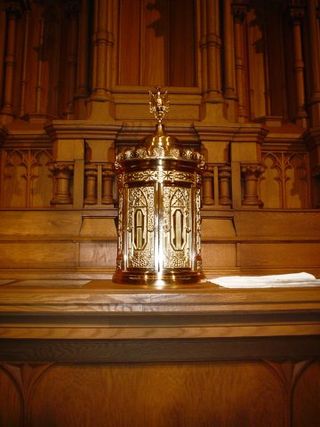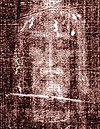
The Eucharist, also known as Holy Communion, Blessed Sacrament and the Lord's Supper, is a Christian rite that is considered a sacrament in most churches, and as an ordinance in others. Christians believe that the rite was instituted by Jesus at the Last Supper, the night before his crucifixion, giving his disciples bread and wine. Passages in the New Testament state that he commanded them to "do this in memory of me" while referring to the bread as "my body" and the cup of wine as "the blood of my covenant, which is poured out for many". According to the Synoptic Gospels this was at a Passover meal.

Transubstantiation is, according to the teaching of the Catholic Church, "the change of the whole substance of bread into the substance of the Body of Christ and of the whole substance of wine into the substance of the Blood of Christ". This change is brought about in the eucharistic prayer through the efficacy of the word of Christ and by the action of the Holy Spirit. However, "the outward characteristics of bread and wine, that is the 'eucharistic species', remain unaltered". In this teaching, the notions of "substance" and "transubstantiation" are not linked with any particular theory of metaphysics.

The epiclesis refers to the invocation of one or several gods. In ancient Greek religion, the epiclesis was the epithet used as the surname given to a deity in religious contexts. The term was borrowed into the Christian tradition, where it designates the part of the Anaphora by which the priest invokes the Holy Spirit upon the Eucharistic bread and wine in some Christian churches. In most Eastern Christian traditions, the Epiclesis comes after the Anamnesis ; in the Western Rite it usually precedes. In the historic practice of the Western Christian Churches, the consecration is effected at the Words of Institution though during the rise of the Liturgical Movement, many denominations introduced an explicit epiclesis in their liturgies.

Host desecration is a form of sacrilege in Christian denominations that follow the doctrine of the real presence of Christ in the Eucharist. It involves the mistreatment or malicious use of a consecrated host—the bread used in the Eucharistic service of the Divine Liturgy or Mass. It is forbidden by the Catholic, Oriental Orthodox, and Eastern Orthodox Churches, as well as in certain Protestant traditions. In Catholicism, where the host is held to have been transubstantiated into the body of Jesus Christ, host desecration is one of the gravest sins. Intentional host desecration incurs the penalty of excommunication latae sententiae. Throughout history, a number of groups have been accused of desecrating the Eucharist, often with grave consequences due to the spiritual importance of the consecrated host.

The real presence of Christ in the Eucharist is the Christian doctrine that Jesus Christ is present in the Eucharist, not merely symbolically or metaphorically, but in a true, real and substantial way.

In Christian theology, the term Body of Christ has two main but separate meanings: it may refer to Jesus Christ's words over the bread at the celebration of the Jewish feast of Passover that "This is my body" in Luke 22:19–20, or it may refer to all individuals who are "in Christ" 1 Corinthians 12:12–14.
The Fraction or fractio panis is the ceremonial act of breaking the consecrated sacramental bread before distribution to communicants during the Eucharistic rite in some Christian denominations.

The Words of Institution are words echoing those of Jesus himself at his Last Supper that, when consecrating bread and wine, Christian Eucharistic liturgies include in a narrative of that event. Eucharistic scholars sometimes refer to them simply as the verba.

A tabernacle or a sacrament house is a fixed, locked box in which the Eucharist is stored as part of the "reserved sacrament" rite. A container for the same purpose, which is set directly into a wall, is called an aumbry.

Memorialism is the belief held by some Christian denominations that the elements of bread and wine in the Eucharist are purely symbolic representations of the body and blood of Jesus Christ, the feast being established only or primarily as a commemorative ceremony. The term comes from the Gospel of Luke 22:19: "Do this in remembrance of me", and the attendant interpretation that the Lord's Supper's chief purpose is to help the participant remember Jesus and his sacrifice on the Cross.

In Christianity, a Eucharistic miracle is any miracle involving the Eucharist. The Roman Catholic, Lutheran, Eastern Orthodox, Methodist, Anglican and Oriental Orthodox Churches believe that Christ is really made manifest in the Eucharist and deem this a Eucharistic miracle; however, this is to be distinguished from other manifestations of God. The Catholic Church distinguishes between divine revelation, such as the Eucharist, and private revelation, such as Eucharistic miracles. In general, reported Eucharistic miracles usually consist of unexplainable phenomena such as consecrated Hosts visibly transforming into myocardium tissue, being preserved for extremely long stretches of time, surviving being thrown into fire, bleeding, or even sustaining people for decades.

Eucharistic theology is a branch of Christian theology which treats doctrines concerning the Holy Eucharist, also commonly known as the Lord's Supper. It exists exclusively in Christianity and related religions, as others generally do not contain a Eucharistic ceremony.

Sacramental union is the Lutheran theological doctrine of the Real Presence of the body and blood of Christ in the Christian Eucharist.

Anglican eucharistic theology is diverse in practice, reflecting the comprehensiveness of Anglicanism. Its sources include prayer book rubrics, writings on sacramental theology by Anglican divines, and the regulations and orientations of ecclesiastical provinces. The principal source material is the Book of Common Prayer, specifically its eucharistic prayers and Article XXVIII of the Thirty-Nine Articles. Article XXVIII comprises the foundational Anglican doctrinal statement about the Eucharist, although its interpretation varies among churches of the Anglican Communion and in different traditions of churchmanship such as Anglo-Catholicism and Evangelical Anglicanism.

Eucharist is the name that Catholics give to the sacrament by which, according to their belief, the body and blood of Christ are present in the bread and wine that are consecrated during the Catholic eucharistic liturgy, generally known as the Mass. The definition of the Eucharist in the 1983 Code of Canon Law as the sacrament where Christ himself "is contained, offered, and received" points to the three aspects of the Eucharist according to Catholic theology: the real presence of Christ in the Eucharist, Holy Communion, and the holy sacrifice of the Mass.

Sacramental wine, Communion wine, altar wine, or wine for consecration is wine obtained from grapes and intended for use in celebration of the Eucharist. It is usually consumed after sacramental bread.

Communion under both kinds in Christianity is the reception under both "species" of the Eucharist. Denominations of Christianity that hold to a doctrine of Communion under both kinds may believe that a Eucharist which does not include both bread and wine as elements of the religious ceremony is not valid, while others may consider the presence of both bread and wine as preferable, but not necessary, for the ceremony. In some traditions, grape juice may take the place of wine with alcohol content as the second element.

Receptionism is a form of Anglican eucharistic theology which teaches that during the Eucharist the bread and wine remain unchanged after the consecration, but when communicants receive the bread and wine, they also receive the body and blood of Christ by faith. It was a common view among Anglicans in the 16th and 17th centuries, and prominent theologians who subscribed to this doctrine were Thomas Cranmer and Richard Hooker.
The Eucharist in the Lutheran Church refers to the liturgical commemoration of the Last Supper. Lutherans believe in the real presence of Christ in the Eucharist, affirming the doctrine of sacramental union, "in which the body and blood of Christ are truly and substantially present, offered, and received with the bread and wine."
Stercoranism is a supposed belief or doctrine attributed reciprocally to the other side by those who in the eleventh century upheld and those who denied the Christian doctrine of transubstantiation, that the bread and wine offered in the Eucharist become in substance, but not in form, the body and blood of Jesus Christ.













